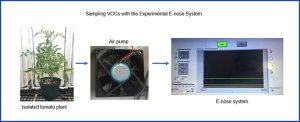E-Nose Device Can Protect Crops by Detecting the Smell of Pests

January 2022 FloridAgriculture eNewsletter
 Whiteflies are a known pest to crops such as tomatoes. When a tomato plant recognizes this intruder, it emits a volatile organic compound, or VOC, to alert other plants. Recently, a team of scientists from the Agricultural Research Service developed the E-Nose device to literally sniff out whitefly infestations of tomato plants.
Whiteflies are a known pest to crops such as tomatoes. When a tomato plant recognizes this intruder, it emits a volatile organic compound, or VOC, to alert other plants. Recently, a team of scientists from the Agricultural Research Service developed the E-Nose device to literally sniff out whitefly infestations of tomato plants.
Fresh market tomatoes held a value of more than $720 million in 2020. Consumer expect a wholesome, safe to consumer product and whiteflies deteriorate the undersides of tomato plants eliminating their use for human consumption. This device is necessary in order to assist not only Florida’s tomato industry but across our nation. Whiteflies can also harbor viral diseases which weaken plants and are transmissible.
The E-nose device is about the size of a shoebox and uses mammalian-like sense of smell to alert for VOCs. When used in greenhouse, the E-nose device displayed the VOC fingerprints of such plants as different lines with different colors that rose sharply and steadily to the right of an LED screen. Moreover, the system distinguished the smell-fingerprints of whitefly-infested tomato plants from un-infested ones, as well as plants whose leaves were punctured with pins for comparison.
According to one of the engineers, Heping Zhu, “The future E-nose system can be designed as a hand-held device for growers to take samples from individual plants. It can also be designed as a computer-controlled cloud networking system which consists of multiple smart sensors placed at different locations in the greenhouse, so the computer can automatically collect samples and monitor infestations 24 hours a day.”
Notes:
Details of the team’s findings were published in the October 2021 issue of Chemosensors and in the August 2019 issue of Sensors.
The Agricultural Research Service is the U.S. Department of Agriculture’s chief scientific in-house research agency. Daily, ARS focuses on solutions to agricultural problems affecting America. Each dollar invested in agricultural research results in $17 of economic impact.




